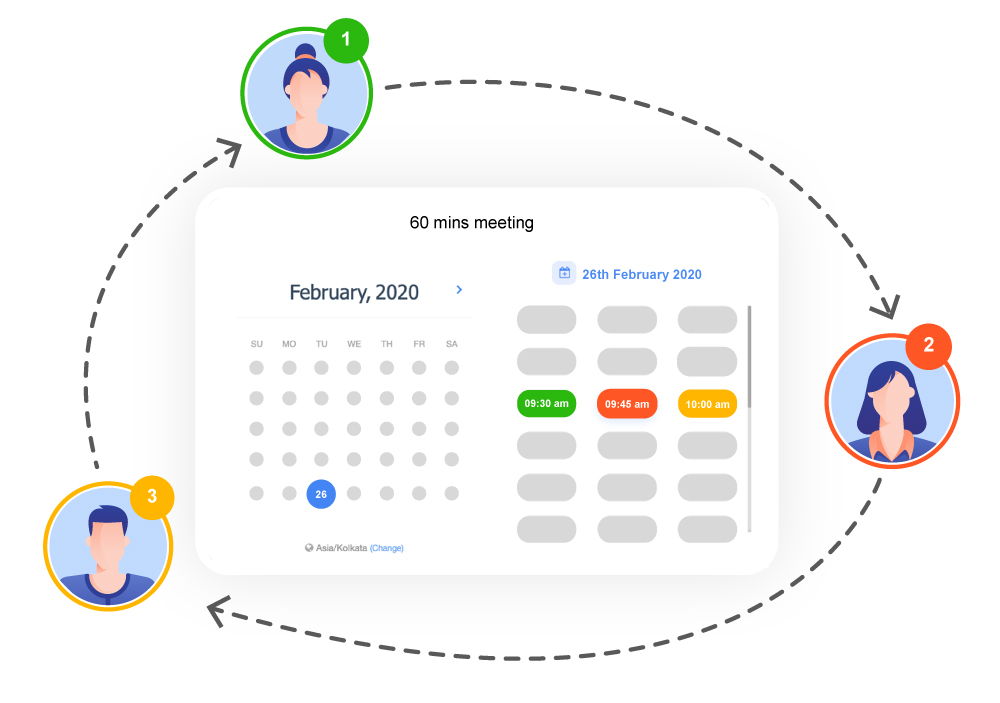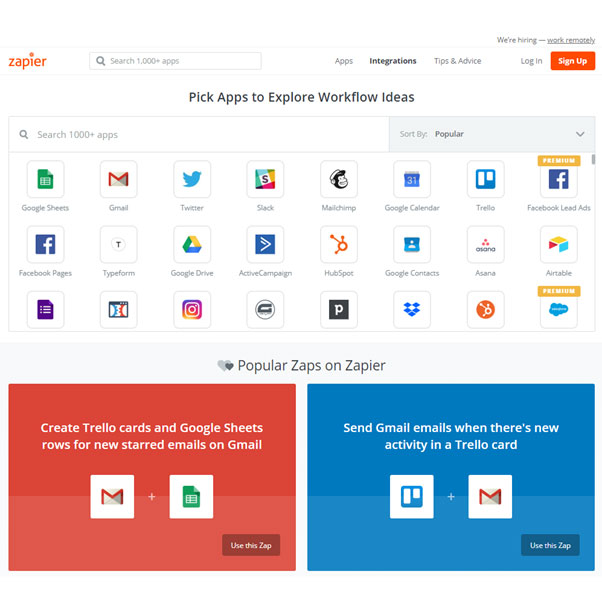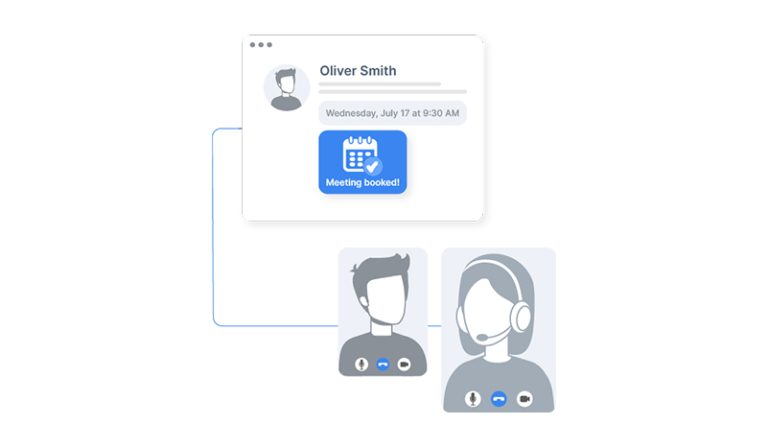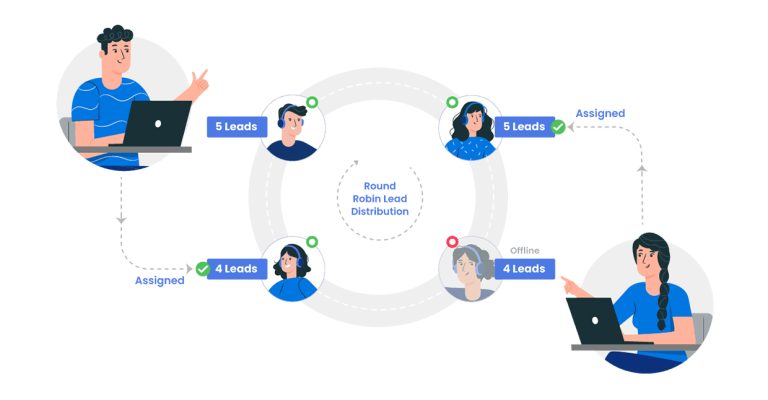Getting a steady stream of leads into your sales pipeline is the ultimate dream, but research indicates it was the biggest challenge faced by more than 61% of marketers in 2022. However, is a ton of leads beneficial to a business if they need to be nurtured to convert into customers? Of course, not!
Did you know that if you make a lead wait more than 10 minutes, the odds of qualifying them drop by 400%? Despite this, 99% of B2B companies fail to respond to their leads within 5 minutes. This can lead to substantial revenue opportunities being missed in spite of capturing them in the first place!
This is why it is essential to direct the leads you capture to your sales reps pronto—so that they can immediately establish communication, qualify them and begin to nurture your potential customers towards a sale. Let’s say you are running a rapidly scaling business— in that case, it can be quite a challenge to maintain fast responses to all lead inquiries in a personalized manner.
This is where lead management practices can be a game-changer. 46% of marketers with well-crafted lead management strategies help their sales reps respond to 75% of leads captured. In growing organizations, lead routing can prove vital in ensuring functional efficiency.
But what is lead routing? And how can lead routing best practices benefit your fast scaling sales processes? Learn about all of these and more, right here!
Let’s get started!
What are the benefits of using a lead routing system?
1. Speed up response times
2. Elevate customer experience
3. Increase the morale for your sales reps
What are some lead routing best practices?
1. Decide on your criteria parameters
2. Assign leads to one particular point of contact only
3. Assign leads based on geographical demographics
4. Do not provide too much information
5. Use simplified lead forms to gather data
What Is Lead Routing?
Lead routing is The practice of allocating incoming leads to sales representatives, often also referred to as lead assignment. In other words, it refers to the distribution of leads among the organization’s team of sales representatives.
Lead routing is a complex process. You can create an alphabetical list of your sales representatives, and give each one a fresh lead as it comes in. (Yes, it is that simple!)
However, assigning leads manually takes a lot of time from numerous team members, costing the business a lot of money. So what can you do? The ultimate solution is to implement automated lead routing systems, enabling businesses to assign leads accurately as they try to reach revenue goals while saving on resources.
The automated lead routing systems might be straightforward or complicated, with several parameters and filters involved. The most complex ones divide up leads according to several criteria, including industry, region, company size, deal potential and much more. Companies implementing these systems can specify the sort order criteria and create unique lead assignment rules.
These tools make the work for sales reps infinitely easier but could be an expensive investment, depending on the level of customisation, this could be better suited to enterprise level sales and marketing initiatives!
It goes without saying, if the lead routing rules you require are simple, then it would definitely be able to fit within your marketing budget.

What Are The Benefits Of Using A Lead Routing System?
Lead routing can help scale your sales strategy and fast-track growth for your business in many ways. Let’s see how implementing a lead routing system can benefit you.
1. Speed up response times
Business is all about getting things done quickly, especially when it comes to following up on a lead that you have added to your sales pipeline!
Responding to a potential sales inquiry as soon as possible may mean the difference between a successful sale and a prospective buyer lost. More than 60% of customers say they tend to hang up on an inquiry call if they are kept on hold for a minute or more!
You may significantly reduce your response time by automating the process of assigning leads to an appropriate sales agent. This ensures that the lead is satisfied at this first hurdle and will willingly move through the following stages towards converting into a paying customer for your brand.
2. Elevate customer experience
Did you know that 59% of customers agree that having their questions solved quickly is an important aspect of their customer experience with a brand?
Every company, whether it serves an individual customer or a business, is driven by the consumer’s needs. Even brand loyalists may break up with your brand in favor of your competitor’s if they believe their concerns are not being addressed in good time.
When a consumer is already interested in your product or service, closing often depends on how quickly and skillfully you were able to address and handle their concerns about your product or service.
Having a sales professional respond to new leads quickly and efficiently, based on their area of expertise, can get a matter of concern resolved sooner, which in turn, makes the customer, potential or present, feel heard and seen. This directly contributes to increased client satisfaction and enhances your brand’s reputation.

3. Increase the morale for your sales reps
Since the customer is to be considered king, your sales reps are bound to attend to lead queries whenever they come in, whether relevant or otherwise. You have to explore every potential revenue-generating opportunity… But if you incur a lot of poor-quality leads, this can get frustrating.
Lead routing systems can help prevent sales reps from burning out over nothing. Before a lead is routed to a suitable sales rep with the necessary experience, it is qualified by the automated lead routing system you have in place. This ensures that the lead matches your business requirements in terms of both need and budget, making it worthy of nurturing and conversion.
Implementing automated lead routing will lead to an increase in morale for your sales reps, which in turn, will result in a lesser churn rate. It will also result in a more productive sales team.
Both of these can be highly beneficial to a rapidly growing business.

4. Generate greater revenue
This is a no-brainer. Here’s the process:
Businesses that utilize the power of lead routing can establish communication with prospective buyers within record time, making sure that they progress to the following stages in the sales funnel. From there, the businesses can further nurture the leads and resolve their issues in greater detail with the help of experienced sales reps—who can further convince them to invest in the product or service.
And once they convert, what does that mean for the business? Revenue, of course! The more leads you can qualify, route, nurture and convert, the higher you can drive the revenue your business generates!

Reasons Why You Should Implement Lead Routing in Your Organization
Here are some reasons why you should implement lead routing in your organization:
1. Faster response time: Lead routing ensures that leads are distributed quickly to the appropriate salesperson or team, which helps to ensure that leads are contacted promptly. This can result in a faster response time and a higher chance of converting the lead into a customer.
2. Improved lead quality: By routing leads to the right salesperson or team, you can ensure that they are better qualified and have a higher chance of converting. This can result in a higher conversion rate and a better return on investment (ROI).
3. Better customer experience: Lead routing can help to ensure that leads are assigned to a salesperson or team that is best equipped to handle their specific needs. This can result in a better customer experience and higher levels of satisfaction.
4. Increased sales productivity: Lead routing can help to ensure that salespeople are only working on leads that are relevant to their expertise and skill set. This can result in increased productivity and efficiency, as well as a higher closing rate.
5. Better data management: Lead routing can help to ensure that all leads are properly tracked and managed within your CRM or sales management system. This can help to ensure that no leads fall through the cracks and that you have a clear understanding of your sales pipeline and performance.
Overall, implementing lead routing can help to streamline your sales process, improve your sales team’s productivity and efficiency, and increase your chances of converting leads into customers.
What are some lead routing best practices?
You may successfully deploy lead routing in three easy steps if you implement automated lead routing software:
- Specify sorting criteria (this could include sorting leads by location, value, industry, specialization, lead score, and other factors);
- Choose the best procedure for your specified criteria, then qualify your lead; and,
- Analyze the procedure to ensure successful repetition and further implementation.
Here are some industry best practices for lead routing:
1. Decide on your criteria parameters
You must have a system in place that swiftly directs new leads to the appropriate sales team professionals. However, you can only achieve this if you establish the proper standards. One metric, for instance, might be if the lead is making the first touch with your organization or was an old client at some point.
Here are some more criteria you can implement:
Company size: You can apply this criterion when your sales crew is segmented into small businesses or startups, mid-sized companies, and large corporations.
Location: When implementing automated lead routing systems, B2B enterprises frequently use the criterion of geography.
Industry: If the sales staff is segmented into groups according to the knowledge of each sector, you should match the leads with the salespeople who specialize in those respective areas.
Lead score: Lead scores are typically used for lead routing by businesses with sophisticated sales models. The criterion gives each produced lead a value or score. The lead scores may be based on factors like geography, value offer, etc. You may discover priority leads using lead scores and conversion strategies.
If the lead is a new client, you can automatically route it to one of your sales representatives so they can determine whether or not the lead has the potential to convert. The relevant account executive can then receive the lead from that sales agent.
The lead should go directly to a team member who already has a relationship with the client. However, if they are an existing customer or an old client returning for more services. The automatic routing of leads to the appropriate sales team members, after being sorted using such criteria, helps expedite the lead assignment process. By automating this procedure, the system can also value leads based on how a potential customer navigates the page and prioritize them accordingly.
2. Assign leads to one particular point of contact only
Converting a new lead to a paying customer (who’s further retained) needs lots of nurturing. Lead nurturing has to be hands-on, which means that a sales rep must always serve as a point of contact at every stage of their customer journey—and the lead should be consistently aware of who it is.
This is why assigning one specific point of contact (POC) is advisable, especially to a new lead. Someone they become comfortable with over time to get in touch with queries or discuss new products or services. This truly betters the customer’s experience with your brand.
However, if the lead is an old customer, a customer success manager should be assigned to them. Why? This is because a CSM is expected to be knowledgeable enough about the lead’s organizational requirements to inform them about new goods or ongoing promotions and upsell or cross-sell products or services accordingly.
Suppose you are using an automated lead management system. Your lead simply receives an email with the following relevant information as soon as they indicate interest.

3. Assign leads based on geographical demographics
This is essential, especially if you are expanding your business in different geographical locations, maybe even other countries!
Sales reps based in the same time zone will be more prompt and responsive to leads based in and around the same geography. It can also be an instant seamless connection between the client and the sales agent.
Additionally, sales reps based in a specific location will be more knowledgeable about the market, the industry trends in the region, and the concerns customers from that particular place are more prone to have. Thus, they will be able to nurture the lead better. They will also be able to arrange meetings more efficiently and communicate with the lead more frequently.
To successfully route leads by territory, the territory must first be defined. Utilizing this information, you should help your sales reps organize CRM data. Following this, you can sort the territory records and allocate any active sales professionals in a given region using the proper lead routing and CRM tools.
4. Do not provide too much information
It is challenging to adhere to this successfully since it might be difficult to categorize what information may be of assistance to your sales representatives or what may lead to bias.
Providing your sales reps with a range of optional information, such as the most recent action a lead completed with your business, can unintentionally encourage your reps to choose only the best leads and ignore others entirely. Your conversion rates will naturally drop as a result, which will eventually harm your sales.
Now, cherry-picking leads based on their surface value is common in sales. It is usually even encouraged to act on instincts, and extract value from the leads these sales professionals think can maximize revenue. However, specific leads might be worked last or even avoided altogether if particular MQL categories are thought to be less desirable. The performance of historically underperforming offers or channels provided to sales as MQL categories may need to improve as a result, which could impair marketing’s efforts to enhance them.
Then, what’s the solution? It is recommended that marketing and sales leadership work together on routine testing that looks for variance in conversion rates concerning how MQLs are classified and delivered to sales reps in order to make sure that sales professionals are not picking and choosing leads that are inversely causing an impact upon the conversion rates of the business.

5. Use simplified lead forms to gather data
For lead generation to occur seamlessly, your forms are crucial. Forms that are not well-crafted or include many irrelevant form fields may make you appear tough to work with and deter potential leads from signing up.
A standard lead capture form will ask for the lead’s name, organization’s name, location, and a phone number to contact them at. They might also enquire about their preferred products. However, less is more when it comes to form fields. After establishing communication with them more directly, you can ask them about their organization and needs.
6. Have a personalized onboarding sequence in place
This is specifically applicable to product and service companies that sell subscriptions. Making that first sale is only the beginning, retaining the customer and inspiring them to become brand advocates is the ultimate goal!
As soon as a lead trusts your offer and invests their money in your product or service, you need to focus on providing them with the best onboarding experience. How can you do that? By routing them to a designated CSM, of course.
The customer service manager then sends new clients a welcome email with clear instructions on how to connect and further utilize the product’s different features. To review how to use any software, they must be able to set up a brief phone call or video conversation.
Once you route the lead (now customer) successfully to the CSM, a vital element in lowering churn is quickly put into action, thereby further providing value.
To make the onboarding process more personalized, you can celebrate customer milestones to ensure that they feel invested in the process or tailor your messaging to speak directly to the key stakeholders in the business.
Steps to implement Lead Routing System in Your Organization
1. Define your lead routing rules: Before you can start routing leads, you need to define the rules that will govern how leads are assigned. This includes things like geographic location, industry, company size, and other relevant factors. You’ll also need to decide how you’ll prioritize leads based on these criteria.
2. Choose a lead routing tool: There are many tools available that can help you automate the lead routing process. Look for a tool that is easy to use, integrates with your existing systems, and provides the features you need to implement your lead routing rules.
3. Integrate your lead routing tool with your CRM: Your lead routing tool should integrate seamlessly with your CRM or sales management system. This will ensure that all leads are properly tracked and managed throughout the sales process.
4. Train your sales team: Your sales team will need to understand how the lead routing system works and how to use the tools that are available to them. Provide training and support to ensure that everyone is comfortable with the new system.
5. Monitor and optimize: Once your lead routing system is up and running, you’ll need to monitor its performance and make adjustments as needed. Look for areas where the system can be optimized to improve lead quality, response time, and overall efficiency.
6. Evaluate the results: After a period of time, evaluate the results of your lead routing system. Look at conversion rates, sales productivity, customer satisfaction, and other key performance indicators to determine whether the system is achieving your goals.
By following these steps, you can implement a lead routing system that streamlines your sales process, improves efficiency, and helps you convert more leads into customers.
Seven Lead Routing Examples
Accelerate your sales process—with lead routing!
Lead routing software is all you need to implement to solve a sluggish or missed response problem and increase speed to lead time. They are proven to improve lead management effectiveness manifold.
An intelligent lead routing strategy enhances user experience and gives leads the information they need to make purchases. Having the proper tools is necessary to guarantee the success of lead routing, though.
Using advanced scheduling platforms like QikChat, you can establish direct communication with your potential customers whenever needed, reaching back out to them in record time. More than 50% of customers agree that they are more likely to buy from the business that responds first.
With automated lead routing and management software, you can stay ahead of your competition and clock in more sales for your fast-growing business.










